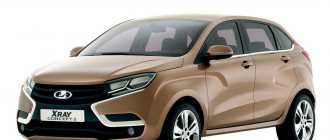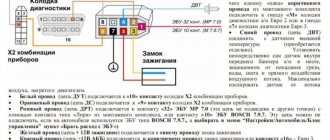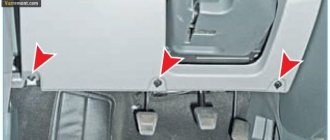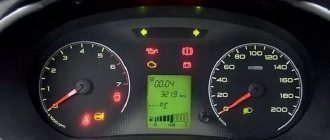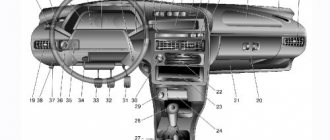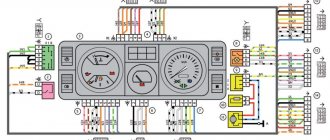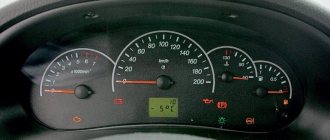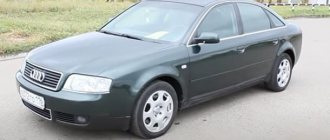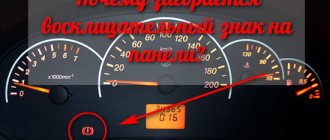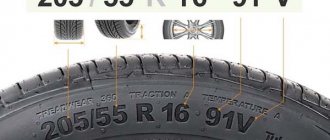Modern cars are equipped with a lot of electronics. To enable timely monitoring and diagnostics, each device is connected to a panel with signal indicators. Each icon has a unique meaning, ensuring there is no confusion while driving. The designation of the icons on the instrument panel is different for each car, which is explained by the difference in the designs of the on-board systems.
The difficulty is that there can be a large number of icons on a modern machine. The following is a description of each symbol separately.
Designations
Modern cars are equipped with a lot of electronics.
To enable timely monitoring and diagnostics, each device is connected to a panel with signal indicators. Each icon has a unique meaning, ensuring there is no confusion while driving. The designation of the icons on the instrument panel is different for each car, which is explained by the difference in the designs of the on-board systems. The difficulty is that there can be a large number of icons on a modern machine. The following is a description of each symbol separately.
Status icons for various vehicle systems and devices
This group of icons is the link between the driver and the car. Icons help him when moving and show activated systems.
This icon is installed on SUVs. It helps you choose the mode of movement required according to the given conditions. If the icon shows the car in a raised position, it means that there is a rise ahead of the driver. If the nose of the car looks down, there will be a descent. Based on the picture, the car enthusiast can increase the gas or, conversely, slow down.
The ASR traction control system is working, this message informs the driver.
The driver is waiting for a turn, the icon indicates. This icon is only placed on vehicles with all-wheel drive. Activation of devices that help the driver during emergency braking. A warning icon indicating problems with the suspension stabilization device. These icons indicate that the blind spot monitoring system is not activated or is faulty. Driver parking assistance system activated. A yellow icon indicates that the device has encountered a problem. The green icon indicates that the lane keeping device is activated. Flashing yellow indicates that the vehicle has changed course. The same color, constantly lit, warns of device failure.
These icons indicate that the vehicle is operating in economy mode.
As you can see from the review, a large number of different icons may appear on the instrument panel. The driver needs to know their meaning. This will help him understand the condition of his car and make it possible to avoid serious repairs.
What icons are there and what do they mean?
Some motorists have always been embarrassed to ask what the car signs that light up on the board mean. Initially, you need to figure out what groups pointers and symbols are divided into.
- Informational – notifies the car owner about the activation of external devices. They are usually green or blue in color.
- Warning - indicate that failures or breakdowns have been detected in the system that require verification. The main color is orange or yellow.
- Emergency. If the red indicator lights up, this indicates that there are critical errors in the device and immediate repair is required.
The groups are further divided into subcategories indicating part of the on-board network. The icons have clarifications in the form of pictures corresponding to the part. There are also letter indices here - the encryption is the same for all cars and is responsible for one circuit.
Note! In 90% of modern cars, when the ignition is turned on, all the indicators on the dashboard light up and go out after 10 seconds. You need to pay attention only to those lamps that are constantly on.
Icon catalog
The complete list of existing icons is most conveniently expressed in a table.
| Appearance | Decoding |
| The presence of such a thermometer indicates that an insufficient or excessive temperature of the coolant in the head radiator has been detected. If the icons are blinking, the lines may be damaged or a fluid leak has been detected. | |
| A red watering can indicates a critical drop in pressure inside the engine lubrication system. | |
| The voltage in the vehicle's on-board network has dropped significantly. The battery needs to be charged or replaced. Indirectly indicates a malfunction of the generator or its wiring. | |
| If the red triangle lights up, this indicates that the car is trying to attract the driver’s attention. Usually illuminated in conjunction with other indicators. | |
| Failure of the electronic stabilization unit of the machine. It may also light up when the system is not working properly. | |
| If the car with a key is on, it can also be installed in the form of a green key - the sign indicates that the immobilizer is activated. | |
| A lock in the background of the car - a critical failure or an error has been detected - the breakdown of the standard anti-theft system. | |
| Installed only on automatic transmission. A red gear sign indicates overheating or a unit error. Additionally, it may be accompanied by a sound signal. | |
| The wrench indicator always indicates individual types of breakdowns. The exact value must be found in the vehicle's service manual. | |
| In 90% of cases it is installed exclusively on modern high-power racing cars. Indicates overheating of the chassis devices. Indirectly indicates the likelihood of loss of control. | |
| An indicator with a picture of a steering wheel indicates that there may be a leak in the power steering housing or a failure of the electric power steering. | |
| The handbrake lever is raised. If the icon is on, you need to remove the car from the handbrake to start driving. | |
| Critical drop in brake fluid level. To continue driving, you need to perform a full diagnostic of the device and add fluid to the tank. | |
| A car with skid marks (the indicator looks like a “slippery road” road sign) indicates that the anti-lock brake system is engaged or faulty. | |
| Critical wear of brake pads. When the symbol lights up, you need to quickly go to a service station for service. | |
| May also be accompanied by the inscription break. Indicates a malfunction or disconnection of the anti-lock brake system. | |
| The brake force distribution device is broken, if the option is present on the vehicle. | |
| Lightning indicated in yellow. Mounted only on modern foreign cars - this indicates a failure or damage to the electronic parking brake control system. | |
| Mounted exclusively on cars with automatic transmission. Indicates the need to hold the brakes to unlock the automatic transmission speed selector | |
| The output from the wheel pressure sensors indicates a drop in pressure inside the tires by more than 25% of the nominal value. | |
| Limitation of power supply to the engine. A yellow indicator indicates the need for an urgent engine check. | |
| The red oil can icon indicates a drop in the oil level in the crankcase. | |
| Airbag failure. If the indicator blinks, this indicates a violation in the blocks responsible for the correct operation of the unit. | |
| The front passenger airbag is deactivated. | |
| If it lights up only when the ignition is turned on, there is nothing terrible. If a fire occurs while driving, it indicates overheating of the automatic transmission components. | |
| The presence of checks on the tidy indicates the need to check the engine - there may be a violation of the internal components of the internal combustion engine. | |
| Engine power has decreased critically. You can remove it by restarting the engine after 10 seconds of inactivity. In turbocharged internal combustion engines, it may indirectly indicate turbine failure. | |
| Malfunctions of the on-board network or electronic systems. | |
| Lambda probe - malfunction or severe blockage. It is necessary to clean or replace the part with a new one. | |
| Indicates a breakdown or overheating of the catalyst. | |
| It is necessary to check that the gas tank is closed correctly. The funnel is located on the side where the fuel tank is located. | |
| An information pointer appears on the board simultaneously with display signals. The purpose of the sign is to inform the driver that there are problems. | |
| A serious error has appeared on the display. The icon shown in the photo indicates the need to read the user manual to resolve the problem. | |
| A leak has been detected in the engine cooling system. Indirectly indicates an increase in engine temperature. Lights up simultaneously with checks or other indicators. Depending on the type of car, the indicators differ, but the meaning is the same. | |
| Damage or incorrect operation of the electronic throttle units. | |
| The icon has a characteristic meaning. The lamp indicates a malfunction or disconnection of the remote tracking system. | |
| In some cars, it indicates the need to evacuate the car - a critical breakdown has been detected. The second meaning is that it is necessary to carry out scheduled maintenance. | |
| Reminder to the driver about the need to change the oil and perform maintenance. | |
| The air filter on the intake system is broken or the element is clogged - replacement is required. | |
| It has three meanings depending on the design of the car. May indicate malfunctions of the traction control system, stabilizers, and electronic differential locks. | |
| 4x4 system activated. The second meaning is that diagnostics of the chassis is required. | |
| The emergency brake assist device is disabled or damaged. | |
| The on-board computer detected that the car was slipping and activated the directional stability modules. In other versions, there may additionally be a drawn snowflake here. | |
| The image of the key and skid marks means that the above system is disabled or disabled. In this case, the car drives normally without the involvement of electronic components. | |
| The four pointers have different purposes. The first and third indicate the absence of an electronic key inside the car. The second and fourth for his presence. | |
| The battery of the electronic keys is worn out; you need to replace the battery immediately. | |
| The option of assistance when starting on snow is included. Additionally, it makes it possible to dose the amount of fuel. | |
| Found on trucks such as Photon Ollin and more “advanced”. The driver is asked to take a break or rest. In Europe, there is a fine for neglecting the indicator. | |
| It acts as part of cruise control and indicates a dangerous approach to a leading vehicle. | |
| Used for trucks, indicates the inclusion of the trailer mode. | |
| Autopilot on the car is turned on. When flashing, the car moves out of the lane; if the lamp is constantly on, a system failure of the program or mechanical damage has been detected. | |
| Stop/start mode failure. Electronic units do not work correctly. | |
| On all-wheel drive models, it indicates that the rear axle is engaged exclusively. | |
| Same with automatic 4x4 connection in a car. | |
| The center differential is locked. | |
| Likewise for the rear axle. | |
| 4x4 is activated, all wheels are in forced rotation mode. | |
| Breakage of the all-wheel drive clutch or breakdown, failure in the internal components of the chassis. | |
| Attention! The car is on the handbrake or a breakdown has been detected, depending on the design of the car. | |
| On electric models, it indicates that a problem has been detected in the high-voltage network. | |
| Malfunction of electronic on-board systems. | |
| The high-voltage battery is discharged and requires charging. | |
| Can be used for electric forklift or modern cars. The device requires recharging. | |
| Indicator of critical reduction in engine power. Possible turbocharger failure. | |
| Malfunction of the horn or similar sound warning devices. | |
| A yellow spiral indicates that the glow plugs are in warm-up mode (for diesel engines only). | |
| If the diesel particulate filter is OK, the indicators should not light up. The presence of icons indicates a blockage or breakdown of the system. | |
| Dry catalyst - too little water for a successful cleaning reaction. | |
| The exhaust cleaning system is faulty and requires repair. | |
| Three indicators with the same meaning. They can be made in the form of a gas station with drops or in the form of a float chamber. They indicate the need to flush the fuel system or the presence of water in it. Additionally, it can signal the need to replace filters. | |
| There is a minimum amount of fuel left in the fuel tank. You need to stop at a gas station. A similar icon is present on the 2109 dashboard produced by VAZ. |
Critical fault icons
Exclamation mark in a circle or the inscription Brake
The handbrake is on or there is a problem with the brake system (low brake fluid level, excessive pad wear, etc.), or a malfunction of one of the sensors.
Blue or red thermometer (thermometer)
Problems with engine temperature. A red thermometer means overheating - you must immediately turn off the engine, a blue thermometer means low engine temperature - you should warm up the engine before driving. These errors can also occur due to faulty temperature sensors.
Oiler with drop (kettle)
Typically indicates low engine oil pressure or a faulty oil pressure sensor. Sometimes this icon also means low oil level, although another designation is more common for the latter (see below).
Oiler with waves or inscriptions Oil level, Min, Sensor
Low engine oil level or faulty oil level sensor. Check the oil dipstick. Some of these icons may also indicate low engine oil pressure.
Battery or battery labeled Main
If the battery light is on, this means the battery is low, the battery is not charging due to a malfunction of the generator or a problem in its circuit. On hybrid cars it is more often found with the inscription Main.
Engine with STOP inscription or simply STOP inscription
This warning light means it is necessary to stop the engine immediately. On VAZ cars this usually means low brake fluid or oil level. The appearance of such an icon may be accompanied by a sound signal. It is better to stop the movement.
Decoding symbols
Modern cars have a large number of symbols and abbreviations that are responsible for individual networks. The full transcript is more readable in table form.
| Indicator | Decoding |
| The indicator indicates that the unit for automatically activating external illuminators is turned on. | |
| The symbol indicates that the adaptive headlight control system is disabled. If the lamp blinks, an error has been detected in the network. | |
| The autopilot system is activated and road markings are monitored. | |
| Duplicates the above system, indicating that the machine is moving to the side. | |
| Malfunction of the start/stop device - the car may not stall at traffic lights. | |
| All-wheel drive mode is activated in normal mode. | |
| Likewise with downshifting (for SUVs). | |
| LOCK – the center differential is turned on, forced drive to all 4 wheels is activated. | |
| It may also look like a green M. The sign indicates that the fuel economy mode is turned on (one or more cylinders are turned off). | |
| Four-wheel drive malfunction. | |
| Mismatch in diameters of front and rear wheels on all-wheel drive. | |
| Overheating of the center differential. It may also indicate a breakdown or breakage of the drive. | |
| Severe overheating of the oil in the rear axle. You need to stop and wait for the lubricant to cool. | |
| Active Steering is enabled. | |
| Problems in the above module. | |
| Driving mode with increased gear ratio is activated. On an automatic, the car starts moving in 2nd gear. | |
| Malfunction of the continuously variable transmission drive. In normal mode, it lights up briefly when the ignition is turned on. | |
| Damage to variable speed steering. | |
| Indicators for switching driving modes. Typically used in modern cars such as Mercedes W164. When one of the indicators is turned on, the engine and suspension settings may change. | |
| The forced delay mode for gear shifting is enabled on automatic transmissions. Allows you to rev the engine as much as possible and is used when overtaking. | |
| Depending on the design of the machine, it may be round in shape and have an exclamation mark. In some trim levels, the exclamation mark lights up separately. The indicator indicates activation of the handbrake and fluid leakage from the lines. | |
| A lubricant leak has been detected from the engine crankcase. There is an urgent need to stop and make up for the loss. | |
| TPMS alert indicates pressure loss. | |
| The ABS device is not working correctly. You must be careful when driving. Also, the ABS icon may indicate a puncture in one of the vehicle’s wheels. | |
| The ESP device is an electronic stability control system designed to assist the driver. When the indicator turns on, the side needs to be checked. | |
| The indicator is found on modern foreign cars. The block helps keep the car in turns. If the EPC fires, you should drive the vehicle with extreme caution - the device is turned off. Similarly, it can be indicated as EPS, but there is no fundamental difference. | |
| Electronic brake force distribution device. EBD helps the driver maintain direction during emergency braking. If the indicator is on, the unit is faulty. | |
| Depending on the manufacturer, they indicate a breakdown of the traction control system. | |
| The electronic kinetic suspension control module is faulty. | |
| They duplicate the meaning of the above picture with the difference in the principle of breakdown. The icon indicates that the device is turned off. | |
| The automatic braking device when approaching a vehicle in front is disabled or broken. Cleaning the external sensors often helps. | |
| The module of electronic assistants when driving the car is broken. The car is controlled normally, but only with the help of mechanics. | |
| It can also be made in the shape of a snowflake. Indicates that driver assistance modes are activated on slippery roads. | |
| Indicator of the position of the car body above the road surface. The option is mounted exclusively on vehicles with air suspension. | |
| Failures were detected in the running parts of the vehicle. | |
| PS | A square indicator may indicate a power steering malfunction or the need to change the filled fluid. |
| Disabling overdrive on an automatic transmission. | |
| The engine needs to be checked. The EPC system can forcefully reduce the power of the power plant. |
Automatic transmission errors
Exclamation mark in a red or yellow gear
A yellow gear error means problems with the automatic transmission and its operation in emergency mode. A red gear can also mean problems with the power unit.
Inscriptions AT or A/T Oil Temp, wrench, thermometer in gear
The inclusion of one of these indicators means there are problems with the automatic transmission - AT (Automatic Transmission). Most often this means overheating of the gearbox oil or a malfunction of the temperature sensor. Yellow lights warn of problems; when the red light comes on, it is better to stop driving. Also, such lights may indicate problems with the transmission control unit.
Car axle with levers
It can mean various problems with transmission components, including overheating of the gearbox, problems with the clutch, and more. For the exact value for your specific vehicle, please refer to your owner's manual.
Gearbox and Auto inscription
This light can only come on on cars with an automatic transmission. Indicates that there are problems with the automatic transmission - low oil level, high temperature, problems with the automatic transmission control unit or sensors.
Up arrow
Indicates the need to change gear to a higher one.
CVT inscription
Error in continuously variable transmission or CVT (Continuously Variable Transmission).
Inscription 2nd STRT
Some cars with an automatic transmission have a second-gear start feature that helps you get started in difficult conditions (icy conditions). When this light is illuminated, the system is activated.
Shoe in a circle with brackets
An indicator that is installed on cars with automatic transmission. Reminds you to press the brake pedal before shifting into gear.
Car icon with wrench
May indicate problems with the engine, transmission or immobilizer. For exactly what this light means in your car, see its instruction manual.
PWR inscription
This light comes on when the “Power” mode is activated in a car with an automatic transmission. In this mode, upshifts occur at higher rpm than usual in order to obtain maximum power.
Inscription O/D Off or Over Drive Off
This light indicates that the OverDrive system is disabled. Available only on cars with an automatic transmission; when this system is turned off, the car will not upshift to save fuel. If there is an OverDrive system, there should also be a button to turn it off.
Decoding the tidy indicators
A separate group of pointers that carry a notification value should be highlighted. Lamps that do not warn of a breakdown, they mean the activation of individual elements and units of the car. A complete breakdown of the indicator lights on the dashboard looks like this.
| Pointer | Meaning |
| Lights up on the dashboard when the daytime running lights (dimensions) are turned on. Found on most modern and classic cars. | |
| Mainly used on trucks and signals the activation of trailer driving mode. | |
| Types of cruise control indicators. If the lamp blinks, this indicates a malfunction in the system. | |
| On modern cars, it indicates activation of the brake system. To unlock, you need to press the gas pedal once. | |
| The sport mode of the suspension and engine is activated. | |
| A similar sign indicates a comfortable rhythm of movement. | |
| The indicator lights only red, indicating that the battery is not charging. If the light blinks, then the problem may be hidden in the generator. | |
| Warning indicators that external lighting devices are not working correctly. The lamp may have burned out or the headlight may have broken. | |
| The blue indicator lights up continuously when the headlights are in high beam mode. When the low beam headlights are turned on, the signal goes out. | |
| The work of the rear feet is impaired. | |
| The side lights are activated. | |
| Front fog lamp activation indicator. | |
| Same for the rear foglights. | |
| It can also be duplicated by the simultaneous blinking of the turn signals, indicating the activation of the alarm system. | |
| Normal operating mode of the parking module. | |
| The above unit is faulty or critically damaged. | |
| Information type signs are mounted mainly on SUVs. Additionally, they can be duplicated by angle degree indicators on the on-board computer display. | |
| Indicators for off/on the hill start assist system. | |
| If a signal appears on the dashboard, it means that the oil pressure inside the engine crankcase is too low. The sign is relatively new; on classics it can be in the form of an ordinary red lamp. | |
| Indicator from built-in tire pressure sensors. Causes of failure: punctures or progressive drop in tire inflation. | |
| The vehicle is driving in economy mode. For some models, one or more cylinders turn off at this moment. | |
| Has a similar meaning. |
Information icons
The machine icon may light up differently; it happens that the “car with a wrench” icon, the “car with a lock” icon, or an exclamation mark are lit. About all these notations in order:
When such an indicator lights up ( a car with a key ), it informs about malfunctions in the engine (often a malfunction of a sensor) or the electronic part of the transmission. To find out the exact cause, you will need to perform diagnostics.
A red car with a lock lights up , which means that there are problems in the operation of the standard anti-theft system, often this icon means that the car does not see the immobilizer key and it will be impossible to start the car, but if this icon blinks when the car is locked, then everything is normal - the car under lock and key.
A yellow vehicle indicator with an exclamation mark notifies the driver of a hybrid vehicle that there is a problem with the electric drive. Resetting the error by disconnecting the battery terminal will not solve the problem - diagnostics are needed.
the open door icon lit when a door or trunk lid is open, but if all the doors are closed and the light on one or four doors continues to shine, then often the problem should be looked for in the door terminals (wire contacts).
The slippery road icon begins to flash when the stability control system detects a section of slippery road and is activated to prevent slipping by reducing engine power and braking the slipping wheel. There is no need to worry in such a situation. But when a key, a triangle, or a crossed out skid icon appears near such an indicator, the stabilization system is faulty.
The wrench icon pops up on the display when it’s time to perform vehicle maintenance. It is an information indicator and is reset after maintenance.
Error codes
A group of errors is highlighted separately. Codes exist for timely detection and elimination of breakdowns. When you turn on the ignition, three or four-digit numbers supported by alphabetic abbreviations may appear on the instrument display.
Service equipment is usually used for detailed reading and decoding of errors. The technician, using a computer with a special program, can determine what each symbol means and where to look for a breakdown.
It is impossible to decipher the designations for different cars in one article; each car model has a unique set of combinations that are not duplicated by analogues.
Description of other important dashboard indicators
Engine Oil Sensor - engine oil level indicator.
An icon with the inscription MAIN usually appears in hybrid models, and it informs about a problem in the power supply system.
The following indicators indicate malfunctions. They are part of the car's security systems.
This indicator lights up along with a warning message on the instrument panel screen.
In European cars, a similar yellow indicator indicates a malfunction of the stability control system.
SRS - Supplemental Restraint System. If this icon lights up, the passive safety system informs you that the airbag is faulty.
The icons on the dashboard do not go out: what to do?
Typically, the indicators light up briefly when the ignition is turned on and should go out after 3-7 seconds. If the lamps continue to burn, this indicates a breakdown has been detected.
Depending on the decoding of the pointer, it is necessary to completely examine the device circuit for short circuits, breakdowns or failures. If you cannot detect the fault yourself, you will need to show the car to specialists.
What do the different signs on the dashboard mean?
60. Stability Control is disabled.
*If the Check Engine light is on, this system will automatically turn off.
Different manufacturers have their own names for this system: Automatic Stability Control (ASC), Dynamic Stability Control (DSC), Vehicle Dynamic Control (VDC), Vehicle Stability Control (VSC) and others.
If the knees begin to slip, the system will begin to level the vehicle using the brake systems, suspension control system, and fuel delivery system.
If the icon blinks, there is an electrical problem with the cooling system.
61. The rain sensor is turned on.
62. When the engine is running, this indicator warns that the engine and its system require diagnostics. This may cause some vehicle systems to shut down and stop working until all problems have been properly corrected.
63. The indicator informs you that the rear window heating is on.
64. Automatic windshield cleaning is activated.
Additional systems
Additional indicators are not responsible for the performance of the head equipment. When the indicators light up, the car can continue to move without negative consequences for the mechanism.
| Appearance | Decoding |
| Requirement to fasten seat belts. Accompanied by a sound signal. | |
| This warning indicates the need to check the tightness of the hoods and doors. | |
| It is necessary to replenish the washer fluid supply - the tank level is almost or completely depleted. | |
| Heated rear window works | |
| The fuel tank is empty - refueling is required. | |
| Used on new foreign cars. The system of automatic switching between the far and near operating modes of the head optics is turned on. | |
| The device for automatically changing the tilt of the optics does not work correctly or is broken. | |
| The above system is disabled. | |
| The DRL device is operating normally. | |
| On modern foreign cars with manual transmission it flashes when you need to upshift. The option can be configured. | |
| A device for facilitating access to the car interior. Exclusively tall SUVs are equipped. During normal operation of the device, the car squats, which ensures comfortable seating for passengers. |
Yellow icons as a warning about the operation of automotive systems
In the era of cars equipped with ESP (Electronic Stability Program) and ASR (Anti-Traction Control) as standard, when we accelerate too quickly or exceed the grip limit on a slippery surface, an orange symbol light comes on on the dashboard.
See also: Guide: The Most Confusing Car Dashboard Icons
In this case, the indication does not prohibit movement, but warns us about the need to reduce speed or release the gas to avoid negative consequences, and also informs us about the start of the system, since the behavior of the car when the additional electronic assistant is turned on can change and take the driver by surprise.
When driving, the yellow ABS warning light will be more important than the red parking brake warning light.
Are the signs different for diesel and gasoline engines?
Due to the similarity of designs, the dashboard icons of diesel and gasoline cars are 90% similar to each other. The only difference is the specific indicators responsible for the diesel power unit.
| Appearance | Meaning |
| Warming up the spark plugs. The icon is activated when the ignition is activated. The engine can be started after the indicator disappears. | |
| Two signs have the same meaning. When they appear, it is necessary to replace or clean the particulate filter. | |
| The emissions in the exhaust cleaning device have been exceeded. | |
| A fuel system failure has been detected. At the same time, the motor may be acting up. Usually the reason lies in air-filled lines and clogged fuel filters. | |
| Water got into the diesel engine. | |
| The timing belt needs to be replaced or tightened. |
Special and additional indicators on the car dashboard
The following indicators can be found in modern vehicles equipped with new technological features.
The green indicator indicates that the function is active.
There are symbols that indicate a problem with a specific function. Typically, such indicators are yellow or red.
The indicator tells the driver that it is time to rest.
Easy access to the car.
Adaptive cruise control activated
Problems with cruise control.
Lane Keeping Assist Indicator.
Such icons may mean:
1. Collision safety system disabled
2. Malfunction in the collision safety system.
The indicator informs you about the risk of a collision at the rear of the vehicle.
The indicator indicates a risk of collision at the front of the vehicle.
Be careful, there is a pedestrian on the road.
The indicator informs you that there is a vehicle in the blind spot.
The indicator informs you that the brake pedal is pressed.
The indicator informs you that the SPORT suspension mode is on.
Towing mode / Indicator indicating the presence of a trailer.
Hybrid car indicators
More advanced hybrids have a complex motor design. A large number of electronics and specific devices have been introduced here. The panel indicators are similarly different.
| Designation | Decoding |
| The main battery is in the process of charging. After the container is filled, the lamp goes out. | |
| Two icons with identical meaning. The signals indicate that the hybrid motor has been switched to electric traction mode. | |
| Both icons indicate that the car is in good working order and ready to move. | |
| A critical motor or electrical failure has been detected. | |
| There is a breakdown on board, you need to show the car to a mechanic. | |
| Battery charging error. On some models it indicates a lack of charge for the engine batteries. |
What do the colors of the icons on the dashboard mean?
Red
Typically, red indicates a serious problem or some unresolved security issue. The color red is also used to indicate important reminders.
Yellow orange)
Typically, icons are colored yellow or orange to indicate that a particular part of the car requires repair or needs servicing. However, if the icon of this color begins to blink, then you should contact the workshop as soon as possible.
Green or blue
Icons of this color are used exclusively to provide the driver with additional information about the stable operation of the system.
Useful tips
* After one red or yellow indicator lights up, you should not wait for others to light up, since the longer you delay visiting the workshop, the greater the risk of an even more serious breakdown of the car increases, which can, in turn, lead to very unpleasant consequences.
* Try to carry out regular technical inspections, which will help avoid unexpected malfunctions. Always pay attention to the dashboard icons and you will be aware of the operation of all vehicle systems.
Security systems
Security systems are displayed on the dashboard in a separate group. Mostly these indicators indicate a violation of the vehicle’s security system. If signals are detected on the dashboard, it is strictly unacceptable to continue driving until the breakdown is eliminated.
| Index | Meaning |
| Both signs indicate a malfunction of the airbag actuators. | |
| The front passenger airbag is disabled. | |
| Switchable passive protection module. If the picture shows OFF, the airbag is faulty. | |
| The side curtains are disabled. Typically, lamps are typical for tall SUVs. If the car is driving on a flat road, you need to check the system. | |
| The pre-emergency safety unit is not working correctly. | |
| The lubricant in the automatic transmission unit is overheated. Movement is not recommended until the module cools down. | |
| The electronics in the automatic transmission are acting up. | |
| The lamp is typical for all-wheel drive vehicles with automatic transmissions. A flashing lamp indicates that the transmission is locked in the parking position. | |
| The ABS design is faulty. The car continues to move, but without the help of electronics. | |
| When the start-stop system is operating, it indicates normal engine operation. | |
| Responsible for the above circuit, indicates an error or breakdown. | |
| The gas tank cap is not closed. | |
| The vehicle tracking system is disabled or malfunctioning. | |
| It is required to perform scheduled maintenance of the vehicle. | |
| The night vision device does not work. It may also indicate burnout of infrared sensors. |
The complete list of icons and indicators is constantly updated. Due to the introduction of new equipment in cars. The electrical design of the car is being improved, which leads to the appearance of new indicators.
Dashboard indicators
40. The red exclamation point can have several explanations, and it looks different:
* If the sign is in a circle, there is a problem with the brake system. It is better to stop and not continue driving.
*Handbrake activated.
* Brake pads are worn out.
* Low brake fluid level. This is the most annoying problem as the brake hose may have been damaged.
Quite often this indicator lights up if the float (level sensor) is faulty.
In some cars, this indicator is accompanied by the word “BRAKE”, but its essence remains the same.
41. Water was detected in the fuel filter.
42. Side Airbag Off - translated as “the side airbag is turned off.” The same icons may indicate that the front airbag is disabled.
43. Fault detected.
44. Low beam headlights are on.
45. The indicator indicates that the air filter is dirty.
46. Fuel saving mode activated. This indicator looks different on different cars.
Color classification. "Traffic light" on the panel
Modern cars sometimes make you feel like a fighter pilot: dozens of indicators and pointers, incomprehensible inscriptions and icons... But the instrument panel is not designed to confuse the driver, but to help him - everything that happens on it is subject to a certain logic.
Clues begin with the color of the light bulb: even without knowing its meaning, you can understand how dangerous the problem that has arisen is, and whether it is a problem in principle. Red lights can be compared to prohibitory traffic rules signs - they signal serious vehicle malfunctions and often require immediate action from the driver. That is why the color red was chosen for them - the color of danger, which immediately catches the eye. The most ominous red indicators are low oil pressure and low brake fluid level; If you see them, you will have to continue the trip by tow truck towards the nearest service station.
Yellow or orange lights warn the driver that something is happening to the car. Generally not dangerous, but if ignored, problems may arise. For example, the low fuel level indicator is illuminated yellow. Is it possible to continue moving? Obviously yes, but in the direction of the gas station. That is, upon seeing a yellow light, the driver must do something - not immediately, but in the near future.
Green lights are informational - they indicate that some system of the car is working normally, but the driver must know about it (and take it into account when driving the car). For example, the turn signal, fog lights or cruise control are on.
Blue lights are rare, indicating some special mode activated in the car. Usually the high beam indicator and - an innovation in modern cars - a cold engine light up in blue. Unlike green icons, blue ones need not only to be taken into account, but also to adjust your actions. For example, do not blind other drivers with high beams or do not put a heavy load on a cold engine.
How to remember the meanings of colors? Take a look at the first three again - doesn’t it remind you of anything? The dashboard uses the same color classification as road traffic lights. A red signal prohibits movement, a yellow one requires attention, and a green signal allows you to drive calmly. The blue color can be roughly equated to green: there is no malfunction, you can drive, but with some reservations.
Explanation of icons on the dashboard of all-wheel drive vehicles
All-wheel drive mode activated (AWD - All-wheel Drive)
The indicator indicates that the all-wheel drive mode with a low range in the transfer case has been engaged.
Central differential lock indicator. The car operates in “hard” all-wheel drive mode.
Rear differential lock indicator
The indicator indicates that all-wheel drive is deactivated.
The indicator informs about a four-wheel drive malfunction.
